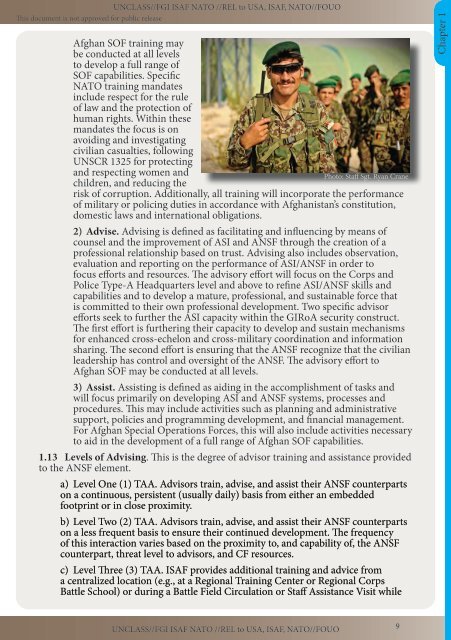20140927_NIU_CJ7_TREX_SFA guide 3.1
20140927_NIU_CJ7_TREX_SFA guide 3.1
20140927_NIU_CJ7_TREX_SFA guide 3.1
You also want an ePaper? Increase the reach of your titles
YUMPU automatically turns print PDFs into web optimized ePapers that Google loves.
UNCLASS//FGI ISAF NATO //REL to USA, ISAF, NATO//FOUO<br />
This document is not approved for public release<br />
Afghan SOF training may<br />
be conducted at all levels<br />
to develop a full range of<br />
SOF capabilities. Specific<br />
NATO training mandates<br />
include respect for the rule<br />
of law and the protection of<br />
human rights. Within these<br />
mandates the focus is on<br />
avoiding and investigating<br />
civilian casualties, following<br />
UNSCR 1325 for protecting<br />
and respecting women and<br />
Photo: Staff Sgt. Ryan Crane<br />
children, and reducing the<br />
risk of corruption. Additionally, all training will incorporate the performance<br />
of military or policing duties in accordance with Afghanistan’s constitution,<br />
domestic laws and international obligations.<br />
2) Advise. Advising is defined as facilitating and influencing by means of<br />
counsel and the improvement of ASI and ANSF through the creation of a<br />
professional relationship based on trust. Advising also includes observation,<br />
evaluation and reporting on the performance of ASI/ANSF in order to<br />
focus efforts and resources. The advisory effort will focus on the Corps and<br />
Police Type-A Headquarters level and above to refine ASI/ANSF skills and<br />
capabilities and to develop a mature, professional, and sustainable force that<br />
is committed to their own professional development. Two specific advisor<br />
efforts seek to further the ASI capacity within the GIRoA security construct.<br />
The first effort is furthering their capacity to develop and sustain mechanisms<br />
for enhanced cross-echelon and cross-military coordination and information<br />
sharing. The second effort is ensuring that the ANSF recognize that the civilian<br />
leadership has control and oversight of the ANSF. The advisory effort to<br />
Afghan SOF may be conducted at all levels.<br />
3) Assist. Assisting is defined as aiding in the accomplishment of tasks and<br />
will focus primarily on developing ASI and ANSF systems, processes and<br />
procedures. This may include activities such as planning and administrative<br />
support, policies and programming development, and financial management.<br />
For Afghan Special Operations Forces, this will also include activities necessary<br />
to aid in the development of a full range of Afghan SOF capabilities.<br />
1.13 Levels of Advising. This is the degree of advisor training and assistance provided<br />
to the ANSF element.<br />
a) Level One (1) TAA. Advisors train, advise, and assist their ANSF counterparts<br />
on a continuous, persistent (usually daily) basis from either an embedded<br />
footprint or in close proximity.<br />
b) Level Two (2) TAA. Advisors train, advise, and assist their ANSF counterparts<br />
on a less frequent basis to ensure their continued development. The frequency<br />
of this interaction varies based on the proximity to, and capability of, the ANSF<br />
counterpart, threat level to advisors, and CF resources.<br />
c) Level Three (3) TAA. ISAF provides additional training and advice from<br />
a centralized location (e.g., at a Regional Training Center or Regional Corps<br />
Battle School) or during a Battle Field Circulation or Staff Assistance Visit while<br />
Chapter 1<br />
UNCLASS//FGI ISAF NATO //REL to USA, ISAF, NATO//FOUO<br />
9


